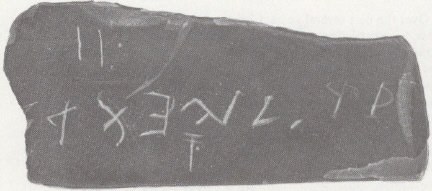The Mystery Of The Bat Creek Stone -- By: Anonymous
Journal: Bible and Spade (First Run)
Volume: BSP 01:1 (Winter 1972)
Article: The Mystery Of The Bat Creek Stone
Author: Anonymous
BSP 1:1 (Winter 1972) p. 26
The Mystery Of The Bat Creek Stone
In 1885, a Smithsonian archaeologist by the name of Cyrus Thomas excavated an Indian burial mound located at the junction of Bat Creek and the Little Tennessee River in Loudon County, Tennessee. Among the finds was a stone inscribed with characters which Thomas reported were “beyond question letters of the Cherokee alphabet”.
The stone received little attention until Dr. Joseph Mahan, Jr., American Indian archaeologist and ethnologist, recently encountered it during a literature search for evidence of early contact between American Indian and eastern Mediterranean cultures. Dr. Mahan brought the stone to Dr. Cyrus Gordon, Chairman of the Department of Mediterranean Studies at Brandeis University, an expert in ancient Mediterranean languages and history.

The mysterious Bat Creek Stone. Hebrew writing or Indian doodlings?
Dr. Gordon concluded that the stone was not inscribed with Cherokee writing, but instead with ancient Hebrew. Based on the evidence of the inscription, he suggests that the stone is nearly 2, 000 years old and attests to pre-Columbian contacts with the New World. He stated that it is “evidence of a migration of Jews from the Near East, probably to escape the long hand of Rome after the disastrous Jewish defeats in 70 and 135 A.D.” The text includes five consecutive Hebrew letters which, Dr. Gordon says, mean “for (the land of) Judah”. The fourth letter, a waw, was inscribed in a style found on Hebrew coins of the Greco-Roman period during which the Jews rebelled against Rome in 66–70 A.D. and 132–135 A.D. “The sole letter on the bottom line is an aleph, the first letter of the alphabet which is used to designate the first year of a reign or era. There is good reason for believing that the text as a whole designates ‘the Golden Age of the Jews: year 1’.”
BSP 1:1 (Winter 1972) p. 27
The Smithsonian Institution does not necessarily agree with Dr. Gordon’s analysis. They say “Current research by Smithsonian Anthropologists neither confirms nor denies Thomas’ identification. A more recent Semitic interpretation of the inscription has not been verified by Smithsonian Scientists.”
Dr. Gus van Beek, Curator of Near Eastern Archaeology at the Smithsonian says that although most of the letters are clearly Hebrew, others are equivocal. He also said, “the tablet has additional scratches on it received since [its picture was] first published. These may indicate that it was not cut in ancient times because both the letters and the scratches have the same patina [surface film]. The stone might go back to Roman times, but it might also be as late ...
Click here to subscribe
